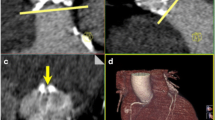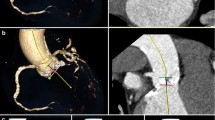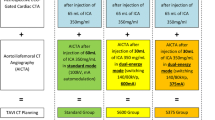Abstract
Purpose
To investigate feasibility, image quality and safety of low-tube-voltage, low-contrast-volume comprehensive cardiac and aortoiliac CT angiography (CTA) for planning transcatheter aortic valve replacement (TAVR).
Materials and methods
Forty consecutive TAVR candidates prospectively underwent combined CTA of the aortic root and vascular access route (270 mgI/ml iodixanol). Patients were assigned to group A (second-generation dual-source CT [DSCT], 100 kV, 60 ml contrast, 4.0 ml/s flow rate) or group B (third-generation DSCT, 70 kV, 40 ml contrast, 2.5 ml/s flow rate). Vascular attenuation, noise, signal-to-noise (SNR) and contrast-to-noise ratios (CNR) were compared. Subjective image quality was assessed by two observers. Estimated glomerular filtration (eGFR) at CTA and follow-up were measured.
Results
Besides a higher body-mass-index in group B (24.8±3.8 kg/m2 vs. 28.1±5.4 kg/m2, P=0.0339), patient characteristics between groups were similar (P≥0.0922). Aortoiliac SNR (P=0.0003) was higher in group B. Cardiac SNR (P=0.0003) and CNR (P=0.0181) were higher in group A. Subjective image quality was similar (P≥0.213) except for aortoiliac image noise (4.42 vs. 4.12, P=0.0374). TAVR-planning measurements were successfully obtained in all patients. There were no significant changes in eGFR among and between groups during follow-up (P≥0.302).
Conclusion
TAVR candidates can be safely and effectively evaluated by a comprehensive CTA protocol with low contrast volume using low-tube-voltage acquisition.
Key Points
• Third-generation dual-source CT facilitates low-tube-voltage acquisition.
• TAVR planning can be performed with reduced contrast volume and radiation dose.
• TAVR-planning CT did not result in changes in creatinine levels at follow-up.
• TAVR candidates can be safely evaluated by comprehensive low-tube-voltage CT angiography.






Similar content being viewed by others
References
Smith CR, Leon MB, Mack MJ et al (2011) Transcatheter versus surgical aortic-valve replacement in high-risk patients. N Engl J Med 364:2187–2198
Achenbach S, Delgado V, Hausleiter J, Schoenhagen P, Min JK, Leipsic JA (2012) SCCT expert consensus document on computed tomography imaging before transcatheter aortic valve implantation (TAVI)/transcatheter aortic valve replacement (TAVR). J Cardiovasc Comput Tomogr 6:366–380
Renker M, Varga-Szemes A, Schoepf UJ et al (2016) A non-contrast self-navigated 3-dimensional MR technique for aortic root and vascular access route assessment in the context of transcatheter aortic valve replacement: proof of concept. Eur Radiol 26:951–958
Sucha D, Chamuleau SA, Symersky P et al (2016) Baseline MDCT findings after prosthetic heart valve implantation provide important complementary information to echocardiography for follow-up purposes. Eur Radiol 26:997–1006
Peeters FE, Kietselaer BL (2016) Editorial to: Baseline MDCT findings after prosthetic heart valve implantation provide important complementary information to echocardiography for follow-up purposes by Sucha et al. Eur Radiol 26:1007–1008
Blanke P, Euringer W, Baumann T et al (2010) Combined assessment of aortic root anatomy and aortoiliac vasculature with dual-source CT as a screening tool in patients evaluated for transcatheter aortic valve implantation. AJR Am J Roentgenol 195:872–881
Apfaltrer P, Henzler T, Blanke P, Krazinski AW, Silverman JR, Schoepf UJ (2013) Computed tomography for planning transcatheter aortic valve replacement. J Thorac Imaging 28:231–239
Blanke P, Schoepf UJ, Leipsic JA (2013) CT in transcatheter aortic valve replacement. Radiology 269:650–669
Faggiano P, Frattini S, Zilioli V et al (2012) Prevalence of comorbidities and associated cardiac diseases in patients with valve aortic stenosis. Potential implications for the decision-making process. Int J Cardiol 159:94–99
Bagur R, Webb JG, Nietlispach F et al (2010) Acute kidney injury following transcatheter aortic valve implantation: predictive factors, prognostic value, and comparison with surgical aortic valve replacement. Eur Heart J 31:865–874
Arnold SV, Lei Y, Reynolds MR et al (2014) Costs of periprocedural complications in patients treated with transcatheter aortic valve replacement: results from the placement of aortic transcatheter valve trial. Circ Cardiovasc Interv 7:829–836
Azzalini L, Abbara S, Ghoshhajra BB (2014) Ultra-low contrast computed tomographic angiography (CTA) with 20-ml total dose for transcatheter aortic valve implantation (TAVI) planning. J Comput Assist Tomogr 38:105–109
Zhang LJ, Qi L, Wang J et al (2014) Feasibility of prospectively ECG-triggered high-pitch coronary CT angiography with 30 ml iodinated contrast agent at 70 kVp: initial experience. Eur Radiol 24:1537–1546
Meyer M, Haubenreisser H, Schoepf UJ et al (2014) Closing in on the K edge: coronary CT angiography at 100, 80, and 70 kV-initial comparison of a second- versus a third-generation dual-source CT system. Radiology 273:373–382
Harris BS, De Cecco CN, Schoepf UJ et al (2015) Dual-source CT imaging to plan transcatheter aortic valve replacement: accuracy for diagnosis of obstructive coronary artery disease. Radiology 275:80–88
Blanke P, Spira EM, Ionasec R et al (2014) Semiautomated quantification of aortic annulus dimensions on cardiac CT for TAVR. JACC Cardiovasc Imaging 7:320–322
Blanke P, Russe M, Leipsic J et al (2012) Conformational pulsatile changes of the aortic annulus: impact on prosthesis sizing by computed tomography for transcatheter aortic valve replacement. JACC Cardiovasc Interv 5:984–994
Commission E (1999) European Guidelines on Quality Criteria for Computed Tomography. Report EUR 16262, Brussels, Belgium
Goetti R, Baumüller S, Feuchtner G et al (2010) High-Pitch Dual-Source CT Angiography of the Thoracic and Abdominal Aorta: Is Simultaneous Coronary Artery Assessment Possible? Am J Roentgenol 194:938–944
Levey AS, Stevens LA, Schmid CH et al (2009) A new equation to estimate glomerular filtration rate. Ann Intern Med 150:604–612
Chen CM, Chu SY, Hsu MY, Liao YL, Tsai HY (2014) Low-tube-voltage (80 kVp) CT aortography using 320-row volume CT with adaptive iterative reconstruction: lower contrast medium and radiation dose. Eur Radiol 24:460–468
Szucs-Farkas Z, Schaller C, Bensler S, Patak MA, Vock P, Schindera ST (2009) Detection of pulmonary emboli with CT angiography at reduced radiation exposure and contrast material volume: comparison of 80 kVp and 120 kVp protocols in a matched cohort. Invest Radiol 44:793–799
Wichmann JL, Hu X, Kerl JM et al (2015) 70 kVp Computed Tomography Pulmonary Angiography: Potential for Reduction of Iodine Load and Radiation Dose. J Thorac Imaging 30:69–76
Wuest W, Anders K, Schuhbaeck A et al (2012) Dual source multidetector CT-angiography before Transcatheter Aortic Valve Implantation (TAVI) using a high-pitch spiral acquisition mode. Eur Radiol 22:51–58
Meinel FG, Canstein C, Schoepf UJ et al (2014) Image quality and radiation dose of low tube voltage 3rd generation dual-source coronary CT angiography in obese patients: a phantom study. Eur Radiol 24:1643–1650
Jilaihawi H, Kashif M, Fontana G et al (2012) Cross-sectional computed tomographic assessment improves accuracy of aortic annular sizing for transcatheter aortic valve replacement and reduces the incidence of paravalvular aortic regurgitation. J Am Coll Cardiol 59:1275–1286
Bittner DO, Arnold M, Klinghammer L et al. (2016) Contrast volume reduction using third generation dual source computed tomography for the evaluation of patients prior to transcatheter aortic valve implantation. Eur Radiol [ePub ahead of print]
Kok M, Turek J, Mihl C et al. (2015) Low contrast media volume in pre-TAVI CT examinations. Eur Radiol [ePub ahead of print]
Nijssen EC, Vermeeren MA, Janssen MM et al (2012) Contrast material-induced nephropathy in the era of hydration. Radiology 265:978–979, author reply 979
Wichmann JL, Katzberg RW, Litwin SE et al (2015) Contrast-Induced Nephropathy. Circulation 132:1931–1936
McDonald JS, McDonald RJ, Carter RE, Katzberg RW, Kallmes DF, Williamson EE (2014) Risk of intravenous contrast material-mediated acute kidney injury: a propensity score-matched study stratified by baseline-estimated glomerular filtration rate. Radiology 271:65–73
Weiland FL, Marti-Bonmati L, Lim L, Becker HC (2014) Comparison of patient comfort between iodixanol and iopamidol in contrast-enhanced computed tomography of the abdomen and pelvis: a randomized trial. Acta Radiol 55:715–724
Acknowledgements
The scientific guarantor of this publication is U. Joseph Schoepf. The authors of this manuscript declare relationships with the following companies: UJS is a consultant for and/or receives research support from Bayer, Bracco, GE Healthcare, Medrad and Siemens. The other authors have no conflicts of interest to disclose. This study was funded by a research grant from GE Healthcare (award number 12-VIS-003), who also provided contrast medium for this study. No complex statistical methods were necessary for this paper. Institutional Review Board approval was obtained. Written informed consent was obtained from all subjects (patients) in this study. No study subjects or cohorts have been previously reported. Methodology: prospective, diagnostic or prognostic study, performed at one institution.
Author information
Authors and Affiliations
Corresponding author
Rights and permissions
About this article
Cite this article
Felmly, L.M., De Cecco, C.N., Schoepf, U.J. et al. Low contrast medium-volume third-generation dual-source computed tomography angiography for transcatheter aortic valve replacement planning. Eur Radiol 27, 1944–1953 (2017). https://doi.org/10.1007/s00330-016-4537-6
Received:
Revised:
Accepted:
Published:
Issue Date:
DOI: https://doi.org/10.1007/s00330-016-4537-6




